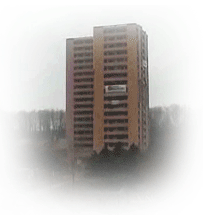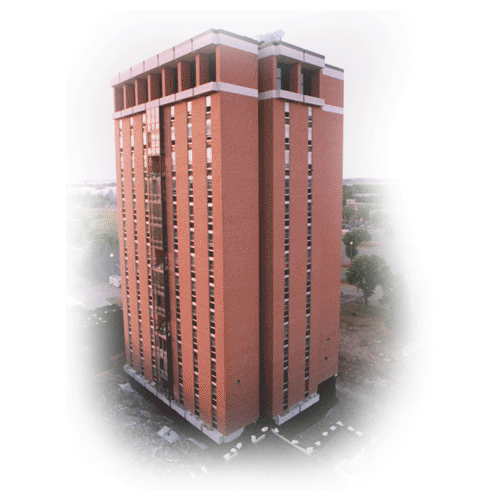

The Supreme Court had on May 8, 2019, ordered the demolition of the four apartment complexes that were built by violating the Coastal Regulation Zone (CRZ) norms, at Maradu municipality in Kerala’s Ernakulam district. The flats were built along the coastal region that falls under the CRZ-III category with strict curbs on construction activities. In such areas, constructions are not allowed within 200 metres from the coastline.
Constructed by: Alfa Ventures Private Ltd
Managing Director: Paul Raj
A high-rise residential complex with twin towers on the shores of the backwaters at Kundannoor. Hotel Le Meridian is on its opposite.
Explosion to be carried out on: Ground floor, 1st, 2nd, 5th, 7th, 9th, 11th and 14th floors.
Demolition date: January 11, Time : 11.30am
Demolition company: Vijay Steels (Chennai)
Cost: Rs 61,00,000
Challenges: 40-odd houses surround the Alfa Serene. It is a densely populated area. Another multi-storeyed building is next to the flat. Explosion has to be carried out without affecting the houses nearby. Cracks have already developed on 18-odd houses in the area. The plan is to make the apartment collapse into the space between the two towers.
Constructed by: Holy Faith Builders & Developers
Managing Director: Sany Francis
Near Kundannoor-Thevara flyover along the Kundanoor backwaters. An 18-floor apartment behind the municipal office.
Explosion to be carried out on: Lower, Upper ground 2nd, 4th, 7th, 10th, 13th and 15th floors.
Demolition date: January 11, Time: 11 am
Demolition company: Edifice Engineering (Mumbai)
Cost: Rs 64,02,240
Challenges: A house at a distance of 1.5 metres away from the flat. Right next to that is the petrohouse of the Bharat Petroleum. The Thevara-Kundannoor bridge is at a distance of 10-metre from the front of the flat. Petrol, diesel pipelines of the IOC also pass through the underground in front of the flat. Fuel would be completely removed and the pipeline would be filled with water for a distance of 16km from Boat Jetty to Irumpanam. The plan is to make the flat collapse at an angle of 36 degree towards the side of the bridge.
Constructed by: K P Varkey & Builders
Managing Director: K V Jose
The building located along the Champakara Canal near the Thaikoodam bridge. This is the first apartment complex to be built 20 years ago when Maradu was a panchayat. The other buildings were given permission in line of this.
Explosion to be carried out on: Ground floor, 1st, 2nd and 7th floors.
Demolition date: January 12, Time: 2pm
Demolition company: Edifice Engineering (Mumbai)
Cost: Rs 21,02,720
Challenges: An anganwadi is located near to the flat. Another multi-storeyed building and several houses in the area. It is feared debris would fall into the backwaters and the area would be engulfed by dust after demolition. The smaller part of the building would be made to collapse towards the Thaikkudam bridge, and the larger portion towards the opposite side.
Constructed by: Jain Housing & Constructions
Managing Director: Sandeep Malik
The building is located along the backwaters at Nettoor. It is the biggest among the buildings to be demolished.
Explosions to be carried out on: Ground floor, Upper ground 1st, 5th, 8th, 11th and 14th floors.
Demolition date: January 12, Time: 11am
Demolition company: Edifice Engineering (Mumbai)
Cost: Rs 86,76,720
Challenges: Flat is surrounded by backwaters. The flat has to be demolished even while ensuring that the rubble does not fall into the backwaters. A KSEB electric tower next to the flat. Another small building is also in the area but fewer houses. The plan is to make flat collapse towards the eastern side.
The first phase involved the inspection of the building plan of the apartment to be demolished. This helped in understanding how the building was constructed and where the main pillars are located. In the second phase, the team of demolition experts inspected the building. The structure of each floor of the building was scrutinised and notes were documented.
In the third phase, the plan for demolition was formulated. This plan was prepared by considering the building plan, inspection of the building and take-aways from earlier demolitions. In some cases, a 3-D model was developed using the computer. This helps in virtually checking what would happen during the time of demolition. A controlled explosion or building implosion method would be used to tear down the multi-storeyed buildings at Maradu within seconds.
The term implosion refers to something collapsing inwards. It is the antonym of explosion, which means blowing apart. The implosion method is used to demolish a building without affecting the nearby buildings. This is based on the principle that if the main pillars of a building are removed, it would collapse on its own. If the upper floors are heavier, when they come crashing down, the lower floors would be destroyed. Explosion would be carried out on several floors to weaken the main pillars. Once the pillars are destroyed, the building would collapse due to the gravitational force.

Determining the time of the detonation is a crucial part of the building implosion method. The impact caused on the earth when the building comes crashing down and the subsequent tremors would depend on this timing. A building implosion carried out with extreme caution would trigger less than 25 millimetres of tremors per second on earth. Several small explosions would be carried out to demolish one building. The first explosions would be on the main pillar of the ground floor. This is to give maximum power in the fall. The pillars for the first demolition are decided based on where the building rubble should fall.

When one pillar is demolished, the other building structures on top of it would start falling down. The speed of the falling rubble would increase by 10 metre per second. Other pillars or beams can turn out to be obstacles in the path of the falling structures. To avoid such obstacles, the explosion would be timed for different floors. Like this, the building would fall on to its base on its own. It is also possible to change the timings of the detonators and make the building fall towards a particular side in the desired angle. Prior to demolition, walls, windows, doors and iron frames of the flats have been removed. Only the pillars and beams are remaining. It has been ensured that there are no hazardous objects. The Maradu flats are now in a fragile state.
H20 Holy Faith
Kundannoor
Jain Coral Cove
Nettoor
Alfa Serene twin towers
Nettoor
Golden Kayaloram
Kannadikadu
PESO-approved blasters have been tasked with the explosion. The blasters and team would be stationed at a distance of 150 metres away from the demolition site with the complete safety system.
H20 Holy Faith
Kundannoor
Jain Coral Cove
Nettoor
Alfa Serene twin towers
Nettoor
Golden Kayaloram
Kannadikadu
Extreme caution should be exercised while removing the rubble. The remains have to be reused as much as possible. Concrete and iron rods would form bulk of the debris. Iron rods can be processed and used again. Concrete parts too can be used in the construction of roads and buildings.